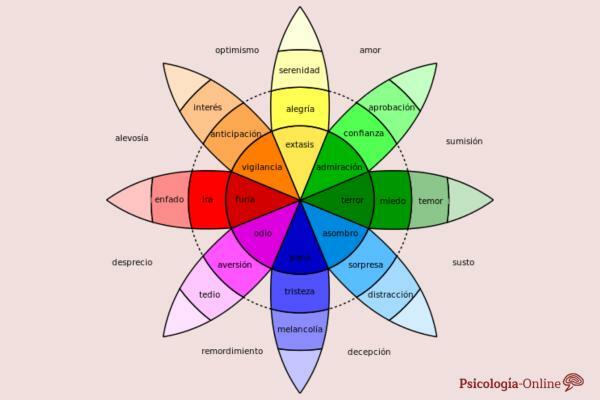
Emotions are part of human beings and there are positive and negative. In general, two groups have been established when classifying them: primary emotions and secondary emotions. The primaries are those that respond to our instincts and are had from birth. For example, sadness, anger, joy, etc. The secondary ones arise as a result of the combination of primary emotions and are learned over time depending on the culture and context in which we find ourselves. These are not universal in all people and the way in which they are expressed may vary.
In this Psychology-Online article, we tell you what are the secondary emotions: what are they, characteristics and examples from the same.
When deciding which emotions could belong to the group of secondary emotions, no consensus was found. Various proposals have been made. Most models, including the Ekman[1]and Plutchik's[2], affirm that the secondary "universal" emotions are the following:
-
Shame: it is a feeling of discomfort for not being accepted by others and a fear of being ridiculed. This makes people transform their way of being, avoid certain situations and do everything possible not to make any mistakes in front of others.
- Guilt: it is a feeling of great discomfort. Who suffers it considers that he has made a terrible mistake and feels deserving of some kind of punishment. It could be said that it is one of the most painful emotions.
- Pride: it is a positive feeling about what one is or one does. It is an emotion, generally adaptive, that refers to a high degree of satisfaction. However, it is possible that this emotion is had in excess and ends up producing a social isolation of the person.
- Pleasure: it is a very positive emotion and is part of the motivation processes. If something produces pleasure, it motivates us to continue doing it. This emotion can occur in any area. In some cases, it can be seen to be distorted.
- Jealousy: it is a feeling of possession and struggles not to lose what we consider to be our own. It has its adaptive biological basis. However, she has a high tendency to become maladaptive by having that feeling in situations that do not correspond.
Secondary emotions have a number of distinctive features. Next, we will see the main characteristics of secondary emotions:
- They are the result of combination of primary emotions.
- Is about learned emotions: normally, they begin to be had at 2 or 3 years of age. This happens because a certain level of consciousness is needed to be able to develop them, that is, they are not automatic or instinctive, as would happen in the case of the primaries.
- They are not universal: they are not the same in all cultures, although they have a certain similar basis.
- They are not automatic or instinctiveContrary to primary emotions, it takes a certain level of consciousness to be able to develop secondary emotions. For this reason they are not universal or equal between different cultures.
- At a general level, they have a higher degree of complexity than primary emotions.
- They contribute to the formation of an identity: they are what differentiates us from each other. Therefore, it influences the way we perceive ourselves and our self-esteem.
In this article, you will see what is the difference between primary and secondary emotions.
We have mentioned some of the secondary emotions that most authors include in their classification. Next, we will see some examples of secondary emotions, how they can develop and how we can understand them:
Shame
In the aforementioned case of shame, we may find ourselves in a social situation in which we do not yet know anyone. At first, the primary emotion of fear of being rejected by the group arises. This emotion has its origin in our biology and obeys the survival instinct. According to this instinct, if we belong to a group there is a better chance of survival.
As a result of that fear, shame appears, making the person self-conscious when acting or avoiding said situation. In this article, we tell you how to lose shame.
Guilt
One of the examples of secondary emotions, specifically guilt, are those situations in which our actions have negative consequences on people we care about. An example of this may be that you have promised your grandmother that you will go to eat with her and in the end you do not go. If your grandmother later tells you that she is sad because you haven't been, that can make you feel guilty for her sadness. Discover how to stop feeling guilty about everything.
Pride
Pride can arise in a number of ways. An example is through the joy when you get a new job or when you finish your university degree. That joy for oneself turns into pride.
However, a combination of go to, sadness Y afraid It can result in another kind of pride. For example, when we do not want to agree with another and admit that we were wrong. Anger for not being correct, along with the sadness of this situation, plus the fear that our conception of ourselves diminishes, turns into pride.
Pleasure
We continue with more examples of secondary emotions. Pleasure is an emotion that can be experienced in many areas. There are countless situations in which we can feel pleasure. For example, you can take pleasure in enjoying a delicious meal, spending the afternoon with friends, getting good grades, or falling in love with someone.
Jealousy
Jealousy is the fear of losing what we consider to be our own. Some examples of jealousy could be when your best friend goes out with other people and doesn't spend as much time with you anymore. jealousy in the couple or the jealousy between siblings. In this article, we tell you how to stop being jealous.
This article is merely informative, in Psychology-Online we do not have the power to make a diagnosis or recommend a treatment. We invite you to go to a psychologist to treat your particular case.
If you want to read more articles similar to Secondary emotions: what are they, characteristics and examples, we recommend that you enter our category of Emotions.


